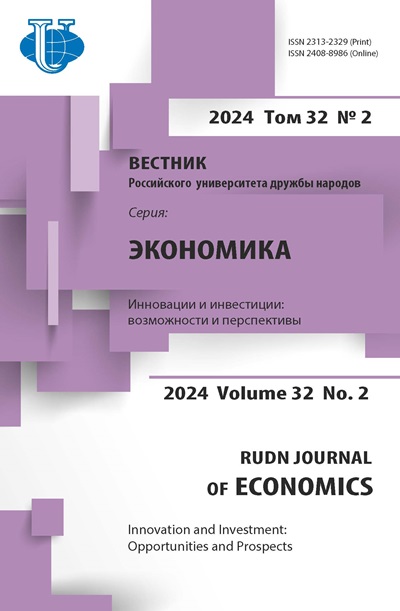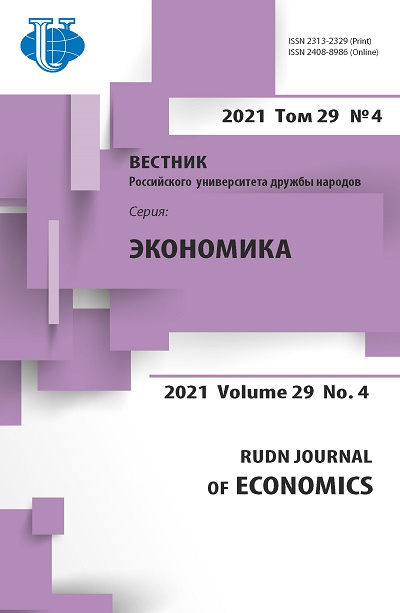Электронная коммерция в КНР в условиях пандемических ограничений COVID-19
- Авторы: Ревинова С.Ю.1, Иващенко Е.А.1
-
Учреждения:
- Российский университет дружбы народов
- Выпуск: Том 29, № 4 (2021)
- Страницы: 699-715
- Раздел: ЭКОНОМИЧЕСКИЕ И СОЦИАЛЬНЫЕ ТРЕНДЫ
- URL: https://journals.rudn.ru/economics/article/view/30102
- DOI: https://doi.org/10.22363/2313-2329-2021-29-4-699-715
Цитировать
Полный текст
Аннотация
Пандемия COVID-19 оказала большое влияние на все сферы жизни, в том числе на электронную коммерцию. Большинство экспертов отмечают положительный эффект, объемы электронной торговли выросли. Одновременно с этим произошли и структурные изменения, потребители сменили свои приоритеты. Целью исследования стало изучение роли электронной коммерции в Китае в период пандемических ограничений, а также анализ статистических и структурных изменений электронной торговли в период эпидемии. Проведен количественный и качественный анализ, определены перспективы электронной торговли в Китае. Также использовались методы статистического и сравнительного анализа. Материалом послужили данные Национального бюро статистики Китая и других отрытых источников. Для определения перспектив электронной торговли построена модель с аддитивной компонентой. Проведена десезонализация данных, рассчитаны несколько вариантов тренда и подобран наиболее подходящий, который лучшим образом аппроксимирует данные о продажах. Анализ показал рост электронной коммерции в период пандемии в Китае, но не такой высокий как ожидался. Отмечается, что и до пандемии электронная коммерция росла довольно быстрыми темпами, а пандемия лишь немного ускорила ее рост. В период пандемии на новые формы продаж вынуждены были перейти и те компании, которые раньше не использовали интернет. Также эпидемия побудила людей попробовать множество новых продуктов и услуг, а затем и развить новые потребительские привычки, что в долгосрочной перспективе продолжит рост электронной торговли.
Ключевые слова
Об авторах
Светлана Юрьевна Ревинова
Российский университет дружбы народов
Автор, ответственный за переписку.
Email: revinova-syu@rudn.ru
ORCID iD: 0000-0002-2442-2393
кандидат экономических наук, доцент кафедры экономико-математических отношений
Российская Федерация, 117198, Москва, ул. Миклухо-Маклая, д. 6Екатерина Александровна Иващенко
Российский университет дружбы народов
Email: 1032182826@rudn.ru
бакалавр экономики, кафедра экономико-математических отношений
Российская Федерация, 117198, Москва, ул. Миклухо-Маклая, д. 6Список литературы
- Agus, A.A., Yudoko, G., Mulyono, N., & Imaniya, T. (2021). E-commerce performance, digital marketing capability and supply chain capability within e-commerce platform: Longitudinal study before and after COVID-19. International Journal of Technology, 12(2), 360. https://doi.org/10.14716/ijtech.v12i2.4122
- Balashova, S., Lazanyuk, I., & Matyushok, V. (2018). Growth scenarios for the Russian economy. In B.S. Sergi (Ed.), Exploring the Future of Russia’s Economy and Markets: Towards Sustainable Economic Development (pp. 235-256). London, Emerald Publishing Limited. https://doi.org/10.1108/978-1-78769-397-520181013
- Beckers, J., Weekx, S., Beutels, P., & Verhetsel, A. (2021). COVID-19 and retail: The catalyst for e-commerce in Belgium? Journal of Retailing and Consumer Services, 62. https://doi.org/10.1016/j.jretconser.2021.102645
- Bhatti, A., Akram, H., Basit, H.M., Khan, A.U., Mahwish, S., Naqvi, R., & Bilal, M. (2020). E-commerce trends during COVID-19 Pandemic. International Journal of Future Generation Communication and Networking, 13(2), 1449-1452
- Chang, H.H., & Meyerhoefer, C.D. (2021). COVID-19 and the demand for online food shopping services: Empirical evidence from Taiwan. American Journal of Agricultural Economics, 103(2), 448-465. https://doi.org/10.1111/ajae.12170
- Dirgantari, P.D., Hidayat, Y.M., Mahphoth, M.H., & Nugraheni, R. (2020). Level of use and satisfaction of e-commerce customers in COVID-19 pandemic period: An information system success model (ISSM) approach. Indonesian Journal of Science and Technology, 5(2). https://doi.org/10.17509/ijost.v5i2.24617
- Dumanska, I., Hrytsyna, L., Kharun, O., & Matviiets, O. (2021). E-commerce and m-commerce as global trends of international trade caused by the COVID-19 pandemic. WSEAS Transactions on Environment and Development, 17, 386-397. https://doi.org/10.37394/232015.2021.17.38
- Guo, H., Liu, Y., Shi, X., & Chen, K. Z. (2020). The role of e-commerce in the urban food system under COVID-19: Lessons from China. China Agricultural Economic Review, 13(2), 436-455. https://doi.org/10.1108/CAER-06-2020-0146
- Güven, H. (2020). Changes in e-commerce in the COVID-19 pandemic crisis process. Eurasian Journal of Researches in Social and Economics (EJRSE), 7(5), 000-000
- Koch, J., Frommeyer, B., & Schewe, G. (2020). Online shopping motives during the COVID-19 pandemic - lessons from the crisis. Sustainability, 12(24). https://doi.org/10.3390/su122410247
- Mazaheri, E. (Ed.). (2020). The impact of COVID-19 on e-commerce. London, Proud Pen. https://doi.org/10.51432/978-1-8381524-8-2
- Nanda, A., Xu, Y., & Zhang, F. (2021). How would the COVID-19 pandemic reshape retail real estate and high streets through acceleration of E-commerce and digitalization? Journal of Urban Management, 10(2), 110-124. https://doi.org/10.1016/j.jum.2021.04.001
- Palomino Pita, A.F., Carolina, M.V., & Oblitas Cruz, J.F. (2020). E-commerce and its importance in times of COVID-19 in Northern Peru. Revista Venezolana de Gerencia, 25(3), 253-266. https://doi.org/10.37960/rvg.v25i3.33367
- Parlakkiliç, A., Üzmez, M., & Mertoğlu, S. (2020). How does COVID-19 pandemic effect online shopping in e-commerce? Journal of Business in The Digital Age, 3(2), 117-122. https://doi.org/10.46238/jobda.823955
- Reshetnikova, M. (2020). Venture capital market in China: A new approach to innovation management. Utopía y Praxis Latinoamericana: Revista Internacional de Filosofía Iberoamericana y Teoría Social, (5), 252-264
- Revinova, S. (2019). E-commerce in BRICS: Similarities and differences. International Journal of Economic Policy in Emerging Economies, 12(4), 377-390. https://doi.org/10.1504/IJEPEE.2019.104632
- Revinova, S., & Lazanyuk, I. (2021). E-learning trends and benefits: Russian realities. INTED2021 Proceedings (pp. 1295-1304). https://doi.org/10.21125/inted.2021.0302
- Sharma, K. (2020). A surge in e-commerce market in India after COVID-19 pandemic. A Global Journal of Social Sciences, 3(December), 54-57
- Veeragandham, M., Patnaik, N., Tiruvaipati, R., & Guruprasad, M. (2020). Consumer buying behaviour towards e-commerce during COVID-19. International Journal of Research in Engineering, Science and Management, 3(9), 78-82. https://doi.org/10.47607/ijresm.2020.292
- Yuan, Y., Guan, M., Zhou, Z., Kim, S., Cha, M., Jin, D., & Li, Y. (2021). Disruption in Chinese e-commerce during COVID-19. Frontiers in Computer Science, 3, 19. https://doi.org/10.3389/fcomp.2021.668711















